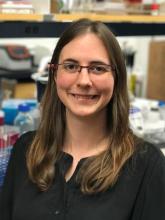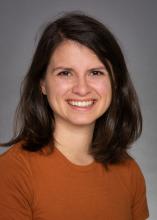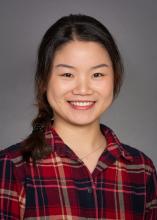The human body is constantly reacting to an ever-changing environment. Negative events often elicit a stress response, such as the immune system arming itself to fight off infection or inflammation due to a traumatic event. Whatever the cause, the response can be complex and multi-faceted as collections of genes are turned on or off via a process known as transcriptional regulation, and the effects are often transient. Attempting to track a whole set of important transcriptional changes associated with human stress responses can certainly be described as challenging. Nonetheless, Ashleigh Theberge's lab at the University of Washington (UW) is diving headfirst into research that aims to identify signs of the body's stress response in two sets of studies that look at the biomarkers in blood. One set focuses on the early immune response to COVID-19 infection and the other on inflammation from wildfire smoke inhalation.
Fang Yun Lim is the postdoctoral researcher in the Theberge group who is spearheading the COVID-19 studies. After spending much of her past scientific career studying the biosynthesis and regulation of secondary metabolites in pathogenic fungi and the role they play in host-pathogen interactions, her efforts to understand the early transcriptional responses to COVID-19 in two observational clinical studies reflect her shift towards translational research. Amanda Haack, an MD-Ph.D. student in the third year of her Ph.D. studies, and Dakota Kennedy, a third year in his Ph.D. program, are both heading the wildfire studies and collaborating with Lim on the COVID-19 studies. Haack aims to make advancements in point-of-care diagnostics in the clinical setting and Kennedy has his focus on projects involving diagnostic technologies; one of these aims to screen for idiopathic infertility in males. In addition, Yuting Zeng, a third-year Ph.D. student in the group, has also joined the work on the wildfire studies.
Building Upon a Pilot Study
“What we’re trying to do is develop a remote blood collection and stabilization method that enables frequent sampling and immediate preservation of the samples in order to understand the immune response to our daily environment,” said Lim. Both the COVID-19 and wildfire studies were the logical off-shoot of a pilot study that was published in October 2021 in Analytical Chemistry. In their publication, they describe homeRNA, a technology designed to give people the ability to draw their blood, preserve it, and then ship it off to be tested. The Theberge group employs the Tasso-SST (serum separator tube), a product made by Tasso Inc. for users to collect blood samples independently. To preserve the RNA—the blueprints of the body's molecular machinery—in the blood, Lim and Haack collaborated to produce a stabilizer solution and a tube that could allow for mixing with the blood sample, minimizing the chance for spills.
"There was a lot of trial and error," said Haack, "I spent the better half of a year designing a tube." After users draw their blood with the Tasso-SST, they connect the collection tube containing their blood samples onto the tube that contains the stabilizer. To avoid spills and sample loss, Haack needed to engineer a tube that sealed the stabilizer tube to the blood sample enough to withstand the mixing process. To achieve this, she engineered a cone-shaped opening to the stabilizer tube that prevented most spills.
The pilot study tested the feasibility that the remote blood sampling kits could be used by the average citizen without any in-person instruction. After its success, the Theberge group naturally looked to ask interesting scientific questions that they could answer with the kits. The constant presence of COVID-19 and near-yearly, record-breaking wildfires in the western U.S. led them to use the kits to ask the following questions: how does the body alter gene expression at the onset of infection, and how does the body react to weeks-long periods of smoke exposure?
Gathering Data through Remote Sampling
"We're flying blind because no one's ever asked this question before, because no one's ever had the power to ask [it]," said Kennedy, referring to the wildfire study. Kennedy noted that the logistics of carrying out the study without a remote sampling technology would be nearly impossible or require a team of hundreds of trained professionals for drawing participants' blood and testing it in various locations. The team originally planned to conduct the pilot study in person on campus, but COVID-19 necessitated remote sampling. "The pandemic really facilitated us being able to do it remotely. We were initially planning to have people come into the lab and use [the kit]. When the pandemic happened, we went full gear into remote sampling," said Haack. Remote sampling then opened the door for the wildfire studies.
The Theberge group at UW in collaboration with Dr. Alpana Waghmare's group at the Fred Hutchinson Cancer Center has since enrolled over 80 participants in the COVID-19 studies and 59 participants in the wildfire studies. “When you get exposed to viral infections, your body responds before you even know you have the infection," said Lim. Alongside their blood sampling, the COVID-19 study participants also did a daily nasal swab to test for any respiratory infections. Lim will look to compare these tests for infection with the snapshots of gene expression in each blood sample.
Each blood sample is analyzed using a molecular barcoding technology known as NanoString. The group is using gene panels designed to detect the RNA transcripts for several hundred genes. By labeling each RNA transcript of interest in a blood sample, the Theberge lab can identify which cellular machinery, or proteins, that the body has activated or suppressed. In turn, this tells them how the body is responding to infection or exposure to wildfire smoke.
Persevering Through the Challenges
Simply put on paper, the project itself was anything but. Human subjects research is hard enough due to all the individual variations and confounding factors that can impact the results. In addition, there is extensive regulatory oversight on human subjects research. The group wrote several institutional review board (IRB) applications to gain permission to send their kits out to people. Lim recalls submitting a 70-page form with 15 supporting documents, just for one of the COVID-19 study IRB applications. The process to gain approval for a study can take months of continuous effort.
Additionally, the project itself has had several challenges. “People are variable to begin with...minimizing that variation so we can reduce the noise and increase the chance of finding biologically meaningful data is pretty challenging,” said Lim. The team also needed to address concerns with shipping. "This person's blood sample is literally just being jostled around in a UPS truck," remembered Kennedy. The fact that the team can collect RNA that is usable for transcriptomics studies is a testament to the robustness of the homeRNA kit. They are currently testing multiple transit scenarios—hot and cold weather, long or short trips—even collaborating with a group in Qatar that tested the quality of blood samples after trips in a car with variable temperatures throughout the journey. Assembling the kits proved to be demanding on its own as the Theberge group raced to ship them out before the onset of wildfire season, immediately after IRB approval in June 2021. "The days that we were shipping out [kits], it was just madness especially in the beginning when we were getting used to getting the kits together," said Haack.
Despite the madness and long hours, they have collected initial participants' samples for the COVID-19 studies and are getting exciting results. "Everybody did it right, and I was blown away." said Kennedy. Now, the Theberge group is sifting through their data, parsing the RNA contents of each blood sample, attempting to glean an answer to their questions. Ahead of them, they hope to apply their remote sampling technology in many other ways including applications surrounding infectious disease, oncology, and autoimmune disorders. Regardless, interesting findings are soon to come out of the Theberge lab as they continue to tease apart the stress responses of the human body.
Story by Gunnar Goetz
Updated Aug. 10, 2022

Gunnar Goetz is a graduate student in the research group of Prof. Sarah Keller where he studies the morphology of phase-separated membranes. Following his experience as a writer for his high school newspaper, Gunnar is pursuing freelance science writing as a possible career after finishing his Ph.D.




